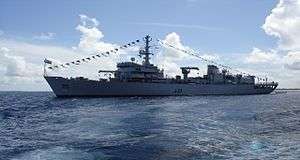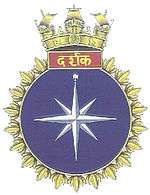INS Darshak
 INS Darshak in Seychelles | |
| History | |
|---|---|
| Name: | INS Darshak |
| Builder: | Goa Shipyard Limited |
| Commissioned: | 28 April 2001 |
| Identification: | J20 |
| Status: | in active service |
| Badge: |
 |
| General characteristics [1] | |
| Type: | Hydrographic survey ship |
| Displacement: | 1,929 long tons (1,960 t) full |
| Length: | 87.8 m (288 ft 1 in) |
| Beam: | 12.8 m (42 ft 0 in) |
| Draft: | 3.3 m (10 ft 10 in) |
| Speed: | 16 knots (30 km/h; 18 mph) |
| Range: | |
| Complement: | 18 officers + 160 enlisted |
| Armament: | 1 × Bofors 40 mm gun |
| Aircraft carried: | 1 × HAL Chetak helicopter |
| Aviation facilities: | Helipad |
INS Darshak (J20) is a hydrographic survey ship in the Indian Navy, under the Eastern Naval Command.
Ship history
Built by Goa Shipyard Limited and commissioned into the Naval service at Visakhapatnam under the command of Captain S.S. Karnik in 2001, Darshak is the Indian Navy's eighth hydrographic survey ship to have been indigenously designed and constructed. Incidentally, the first indigenously built survey ship of the Navy, inducted in 1964 and decommissioned in 1990, was also named INS Darshak.
The new Darshak is equipped with a range of surveying, navigational and communication systems. The next-generation surveying systems provided onboard include the multi-beam swath echo sounding system, differential global positioning system, motion sensors, sea gravimeter, magnetometer oceanographic sensors, side scan sonars and an automated data logging system. These are designed to meet the stringent international/ISO 9002 digital survey accuracy standards required for the production of electronic navigation charts and publications.
The Darshak is powered by two diesel engines and is capable of sustained speeds. The ship's multi-role capability places her in the league of the most versatile survey vessels in the world. It can undertake a variety of tasks under trying conditions.
Archaeological investigations
INS Darshak was used to investigate historically significant shipwrecks off the coast of Tamil Nadu. This included exploring the submerged remains of the lost city of Poompuhar in Tamil Nadu.
Darshak, under the command of Captain P. Jayapal, was deployed off Poompuhar, about 15 nautical miles (28 km) north of Nagapattinam. The ship carried out an extensive hydrographic survey and diving operations in the area off the Tharangambadi coast. During the operations, which lasted for nearly a month, the ship recovered some objects of archaeological importance. A ‘U’ shaped structure, located three miles (5 km) off the coast at a depth of 23 metres, was discovered during one of the dives. The structure was 85 metres in peripheral length and about two metres in height while the distance between the arms was about 13 metres. The structure was covered with marine growth and the centre was buried under silt. Local fishermen claimed that the structure was one of six such submerged structures.
Darshak also recovered a shipwreck supposed to be of a Dutch ship sunk by the French near the end of the 18th century. Three lead ingots, each about a metre long and weighing approximately 80 kg, were recovered by divers. They were marked with "W. Blackett" which was the name of a British company and the marking "1792" which is presumed to be the date of their manufacture. Moreover, the ingots bear the emblem of the Dutch East India Company.
Navy divers carried out further dives at the site and identified a two-metre long cannon which, although attached to the wreck, was deeply embedded in the seabed. The ship’s diving team managed to recover the cannon, despite adverse sea conditions and the ship not being equipped to carry out excavations. The cannon, which was covered with extensive marine growth, is 2.1 metres in length and weighs approximately 700 kg.
References
- ↑ "J 18 Sandhayak Class". globalsecurity.org. 2012. Retrieved 24 February 2012.
External links
| Wikimedia Commons has media related to INS Darshak (J20). |